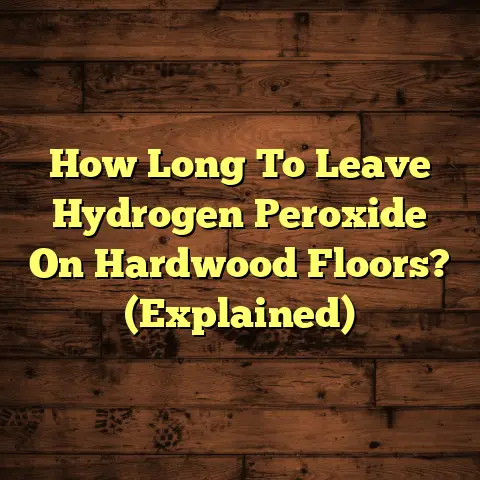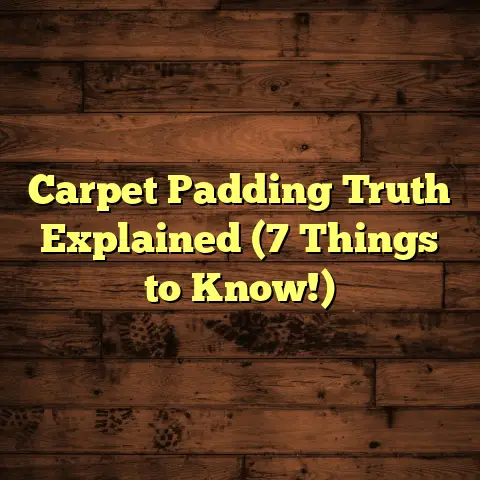Sanding Hardwood: DIY or Hire a Pro? (5 Questions)
I’m a flooring contractor, and I’ve seen it all.
One thing I hear constantly is frustration over hardwood floors that have lost their luster.
Scratches, dullness, damage – it all detracts from the beauty of your home, right?
It always boils down to this: Do you grab the sander yourself, or call in a professional?
That’s a big question, and I’m here to help you answer it. Let’s dive in!
1. What are the signs that your hardwood floor needs sanding?
Okay, so how do you really know if your floor needs a refresh? It’s more than just a hunch.
Here’s what I look for:
-
Visible Scratches: This is the most obvious. Are there surface scratches from pets, furniture, or just everyday wear and tear? If so, sanding is likely in order.
-
Uneven Surface: Feel around. Are there areas where the finish is completely worn away, or places where the wood feels rough?
-
Dull Finish: Has your floor lost its shine, even after cleaning? A worn finish can make your entire room look drab.
-
Water Damage/Stains: Dark spots or discoloration often indicate water damage that sanding can address.
-
Old, Worn Finish: Sometimes, the existing finish is just old and tired. It might be yellowed or cracked, and sanding can give you a fresh start.
How to Assess the Condition:
Get down on your hands and knees! Really inspect the floor in different lighting conditions.
Use a flashlight to highlight scratches and imperfections.
Pay close attention to high-traffic areas like hallways and entryways.
If you’re unsure, take some close-up photos and compare them to photos of freshly sanded floors online. That can give you a good visual reference.
2. What does the sanding process entail?
Alright, let’s break down the sanding process. It’s more than just running a machine over your floor.
The Basics:
Sanding removes the old finish and a thin layer of wood, creating a smooth, even surface for a new finish to adhere to.
Equipment:
-
Drum Sander: This is the big kahuna. It’s used for the initial sanding and removes the most material. It’s powerful, and you really need to know what you’re doing to avoid damaging your floor.
-
Edger Sander: This gets the edges and corners that the drum sander can’t reach. It’s smaller and more maneuverable.
-
Orbital Sander: This is used for the final sanding and creates a super smooth surface. It’s more forgiving than a drum sander, making it better for DIYers.
-
Shop Vacuum: Essential for cleaning up the dust between sanding passes.
-
Personal Protective Equipment (PPE): Safety glasses, dust mask, and ear protection are a must! Seriously, don’t skip this.
Techniques:
-
Drum Sanding: Use overlapping passes, moving with the grain of the wood. Don’t stop the sander while it’s on the floor, or you’ll create dips.
-
Orbital Sanding: Move the sander in a circular motion, again with the grain. Use progressively finer grits of sandpaper.
Step-by-Step (Simplified):
-
Preparation: Remove all furniture, cover doorways with plastic sheeting to contain dust.
-
Initial Sanding (Drum Sander): Use a coarse grit sandpaper (e.g., 36-grit) to remove the old finish and level the floor.
-
Edge Sanding (Edger Sander): Sand the edges and corners to blend with the drum-sanded areas.
-
Intermediate Sanding (Drum Sander): Use a medium-grit sandpaper (e.g., 60-grit) to smooth out the floor.
-
Final Sanding (Orbital Sander): Use a fine-grit sandpaper (e.g., 100-grit or higher) for the final smoothing.
-
Vacuuming: Thoroughly vacuum the floor and walls to remove all dust.
-
Finishing: Apply stain (if desired) and several coats of polyurethane or other finish, following the manufacturer’s instructions.
DIY vs. Pro:
A professional will have years of experience and access to better equipment. They’ll also be able to identify potential problems (like hidden nails or uneven subfloors) and address them properly.
DIYers can save money, but they need to be prepared to invest time and effort, and accept the risk of making mistakes.
3. What are the cost implications of DIY sanding versus hiring a professional?
Let’s talk money. This is where things get real.
DIY Costs:
-
Sander Rental: Expect to pay around \$50-\$100 per day for a drum sander and edger. Orbital sanders are cheaper to rent or buy.
-
Sandpaper: Sandpaper costs can add up quickly, especially if you need multiple grits. Expect to spend \$50-\$100.
-
Finish: A gallon of polyurethane can cost \$50-\$100, and you’ll likely need at least two coats.
-
Other Materials: Tack cloth, plastic sheeting, tape, and other supplies can add another \$20-\$50.
-
Unexpected Costs: This is where things can get tricky. What if you damage the floor and need to repair it? What if you need to rent the sander for an extra day? Always factor in a buffer.
Professional Costs:
-
Labor: Labor costs vary depending on your location and the contractor’s experience. Expect to pay \$3-\$8 per square foot.
-
Materials: The contractor will typically include the cost of materials in their estimate.
Example Breakdown (1,000 sq ft Floor):
| Cost | DIY Estimate | Pro Estimate |
|---|---|---|
| Sander Rental | \$200 | Included |
| Sandpaper | \$75 | Included |
| Finish | \$150 | Included |
| Other | \$50 | Included |
| Labor | Your Time! | \$3,000-\$8,000 |
| Total | \$475 | \$3,000-\$8,000 |
Financial Considerations:
DIY sanding is definitely cheaper upfront. However, if you make mistakes that require professional repair, you could end up spending more than if you had hired a pro from the start.
Here’s a reality check: According to HomeAdvisor, professional hardwood floor sanding costs between \$1,074 and \$2,487, with a national average of \$1,768. (https://www.homeadvisor.com/cost/flooring/refinish-hardwood-floors/)
4. What are the risks and benefits associated with each option?
Let’s weigh the pros and cons. It’s not just about money; it’s about your time, skill, and peace of mind.
DIY Sanding:
Benefits:
-
Cost Savings: The most obvious benefit. You can save a significant amount of money on labor costs.
-
Flexibility: You can work at your own pace and on your own schedule.
-
Sense of Accomplishment: There’s a certain satisfaction that comes from doing it yourself and seeing the results.
Risks:
-
Damage to the Floor: This is the biggest risk. Drum sanders are powerful machines, and it’s easy to gouge or unevenly sand the floor if you’re not careful.
-
Inconsistent Finish: Achieving a professional- looking finish requires skill and experience. You may end up with lap marks, uneven color, or other imperfections.
-
Time Commitment: Sanding a floor is a time- consuming process. It can take several days, even for a small room.
-
Dust and Mess: Sanding creates a lot of dust. Even with proper precautions, it can be difficult to contain.
-
Health Risks: Breathing in sanding dust can be harmful to your lungs. Always wear a dust mask.
Hiring a Professional:
Benefits:
-
Expertise and Experience: Professionals have the knowledge and skills to sand your floor properly and achieve a beautiful, durable finish.
-
Quality Equipment: They have access to better equipment than you can rent, which can result in a smoother, more even surface.
-
Time Savings: They can complete the job much faster than you can, freeing up your time for other things.
-
Less Mess: They have dust-containment systems that minimize the amount of dust that escapes into your home.
-
Warranty: Most professionals offer a warranty on their work, so you’re protected if something goes wrong.
Risks:
-
Cost: The biggest drawback. Hiring a professional can be expensive.
-
Finding a Reputable Contractor: You need to do your research to find a contractor who is qualified, experienced, and trustworthy.
-
Disruption to Your Home: Even with dust- containment systems, sanding can be disruptive to your home life.
Do you have the skills?
Be honest with yourself. Are you comfortable using power tools? Do you have experience with woodworking or other DIY projects?
If not, hiring a professional might be the better option.
5. How to choose the right sanding method for your specific hardwood type?
Not all hardwood is created equal. The type of wood you have will affect the sanding process.
Wood Hardness:
-
Janka Hardness Scale: This scale measures the resistance of wood to denting and wear. Softer woods require a more gentle sanding approach.
-
Examples: Brazilian Cherry (Janka: 2350) is very hard, while Pine (Janka: 380) is very soft.
Grain Patterns:
-
Open-Grain Woods: Oak and Ash have open grains that can absorb stain unevenly if not properly sanded.
-
Closed-Grain Woods: Maple and Cherry have closed grains that are easier to sand and finish evenly.
Previous Finishes:
-
Surface Finishes: Polyurethane and varnish are surface finishes that sit on top of the wood. They are relatively easy to sand off.
-
Penetrating Finishes: Oil-based finishes penetrate the wood and can be more difficult to remove.
Here is a quick table to reference:
| Wood Type | Janka Rating | Sanding Considerations |
|---|---|---|
| Oak | 1290-1360 | Common, sands well, but be careful not to over-sand the open grain. |
| Maple | 1450 | Dense, requires sharp sandpaper and a consistent technique to avoid swirl marks. |
| Cherry | 950 | Softer, sands easily but can be prone to scratches, so use finer grits. |
| Pine | 380-870 | Very soft, requires gentle sanding to avoid gouging. |
| Brazilian Cherry | 2350 | Extremely hard, requires aggressive sanding and durable sandpaper. |
Tips for Specific Wood Types:
-
Soft Woods (Pine, Fir): Use a lighter touch and finer grits of sandpaper to avoid damaging the wood.
-
Hard Woods (Oak, Maple): You can use more aggressive sanding techniques, but be careful not to over-sand.
-
Exotic Woods (Brazilian Cherry, Ipe): These woods are often very dense and require specialized sanding techniques. Consider hiring a professional for these.
If you’re not sure what type of wood you have…
Take a sample to a local flooring store or lumberyard. They can usually identify it for you.
Conclusion
So, there you have it. Sanding hardwood floors is a big job, and the decision of whether to DIY or hire a pro depends on a lot of factors.
Consider your budget, your skill level, and the condition of your floors.
If you’re comfortable with power tools and have the time and patience, DIY sanding can be a rewarding experience.
But if you’re unsure of your abilities or have valuable or difficult-to-sand floors, hiring a professional is usually the best option.
No matter what you decide, take your time, do your research, and be prepared for a lot of dust!
Good luck, and happy sanding!





